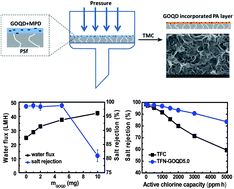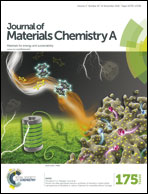Pressure-assisted preparation of graphene oxide quantum dot-incorporated reverse osmosis membranes: antifouling and chlorine resistance potentials†
Abstract
Graphene-based nanomaterials have opened a new era in the fabrication of novel membranes with outstanding performance. In this study, we propose a new method of fabricating a graphene oxide quantum dot (GOQD)-incorporated thin-film nanocomposite (TFN) membrane for reverse osmosis (RO) applications. Inspired by free-standing graphene membranes prepared by vacuum filtration, an aqueous suspension of GOQD/m-phenylenediamine (MPD) was first filtered onto a polysulfone (PSf) substrate to obtain a cushion layer. A GOQD-incorporated polyamide (PA) selective layer was then constructed by interfacial polymerization between MPD and trimesoyl chloride (TMC). This method can easily be scaled up owing to its simple preparation procedures. The newly developed TFN membrane exhibited stable high performance with a flux of 37.5 L m−2 h−1 and a NaCl rejection of 98.8% at 16 bar. Remarkably, this represents a 51.8% increase in permeate flux relative to a GOQD-free TFC membrane without compromising the solute rejection. In addition, the GOQD-incorporated TFN membrane displayed long-term durability over 120 h of RO testing. More importantly, the introduction of GOQD into the TFN membrane resulted in improved antifouling and chlorine resistance properties, which are greatly desired in the membrane desalination and water reclamation processes.


 Please wait while we load your content...
Please wait while we load your content...